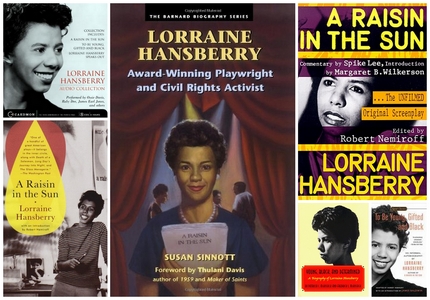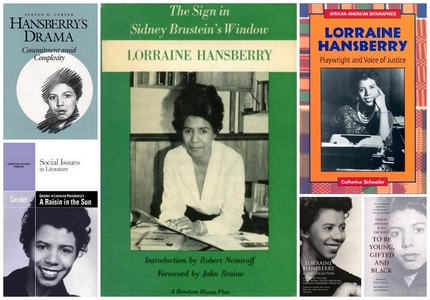Fembio Specials Famous Lesbians Lorraine Hansberry
Fembio Special: Famous Lesbians
Lorraine Hansberry

(Lorraine Vivian Hansberry)
born May 19, 1930 in Chicago
died January 12, 1965 in New York City
US-American playwright
50th anniversary of death on 12 January 2015
Biography • Literature & Sources
Biography
Lorraine Hansberry, child of a cultured, middle-class black family but early exposed to the poverty and discrimination suffered by most blacks in America, fought passionately against racism in her writings and throughout her life. Best known for her plays, Hansberry was the first black woman to write a Broadway drama; A Raisin in the Sun (1959) became the longest-running black play in Broadway's history and made many consider Hansberry the most promising playwright of her generation, although her career was cut short by her early death. Angry about the way blacks had been portrayed in literature by whites, she intended to show “that we have among our miserable and downtrodden ranks people who are the very essence of human dignity.” 
Hansberry's father was a successful real estate broker and founded one of the first Negro banks in Chicago. Her mother, a major force in Hansberry's life, had been a hairdresser, cashier, and schoolteacher in the south, and like her father, was active in politics. The family fought against discrimination it experienced when it tried to own a home in a white neighborhood by successfully bringing a civil-rights case all the way to the US Supreme Court. After receiving a ghetto education in a segregated school system, Hansberry attended the University of Wisconsin for two years, then studied painting in Chicago and Mexico. In 1950 she moved to New York, where she began to write for Paul Robeson's monthly paper Freedom and was an outspoken activist for peace and racial justice. Among other things she wrote articles on women and on Africa; she met and studied with the black leader and scholar W.E.B. Du Bois. On a picket line protesting racial discrimination, Hansberry met her husband, Robert Nemiroff, who became a songwriter and producer after their marriage in 1953; the two maintained a close and fruitful working relationship, even though they ended the marriage in 1964. A Raisin in the Sun, Hansberry's first and most successful play, tells about the struggles of a poor black family to realize its dreams in a prejudiced society; in particular the son Walter Lee Younger grows from a desperate desire for status and materialistic success to an affirmation of inner values. The daughter Beneatha offers a positive image of a black woman, in her intelligence and firm ambition to attend medical school. The play was awarded the New York Drama Critics Circle Award in 1959, beating out plays by Tennessee Williams and Eugene O'Neill. It was made into a movie in 1961, and has been one of the most widely anthologized American plays. Her next, more complex but less successful play was The Sign in Sidney Brustein's Window (1964), a drama defending commitment and attacking cynicism and despair.
Hansberry had become ill with cancer in 1963 and died soon after this second play opened. Over 600 attended her funeral in Harlem, at which there were messages read from Martin Luther King, Jr. and James Baldwin, and tributes presented in person by Paul Robeson, Ruby Dee, Nina Simone and others. 
Nemiroff compiled To Be Young, Gifted and Black (1969), originally a seven-hour radio program based on Hansberry's dramatic writings, speeches and letters; it was made into a stage version and toured over 200 colleges and 40 states after a long run in New York. Her other completed plays include Les Blancs, one of the first examinations of contemporary Africa and the struggle for black liberation by a black American; The Drinking Gourd, and What Use are Flowers? (both published in 1972). The former is a powerful script about US slavery, commissioned for television but never performed, and the latter an allegory of existence after nuclear destruction.
For additional information please consult the German version.
Author: Joey Horsley
Literature & Sources
Sources: Carter, Steven R. 1991. Hansberry's Drama: Commitment Amid Complexity. Urbana, IL. Univ. of Illinois Press.
Cheney, Anne. 1984. Lorraine Hansberry. Boston. Twayne.
Hansberry, Lorraine. 1970. To Be Young, Gifted And Black: Lorraine Hansberry in Her Own Words. Adapted by Robert Nemiroff, with original drawings and art by Miss Hansberry and an introduction by James Baldwin. New York, N.Y. Signet Books.
If you hold the rights to one or more of the images on this page and object to its/their appearance here, please contact Fembio.


